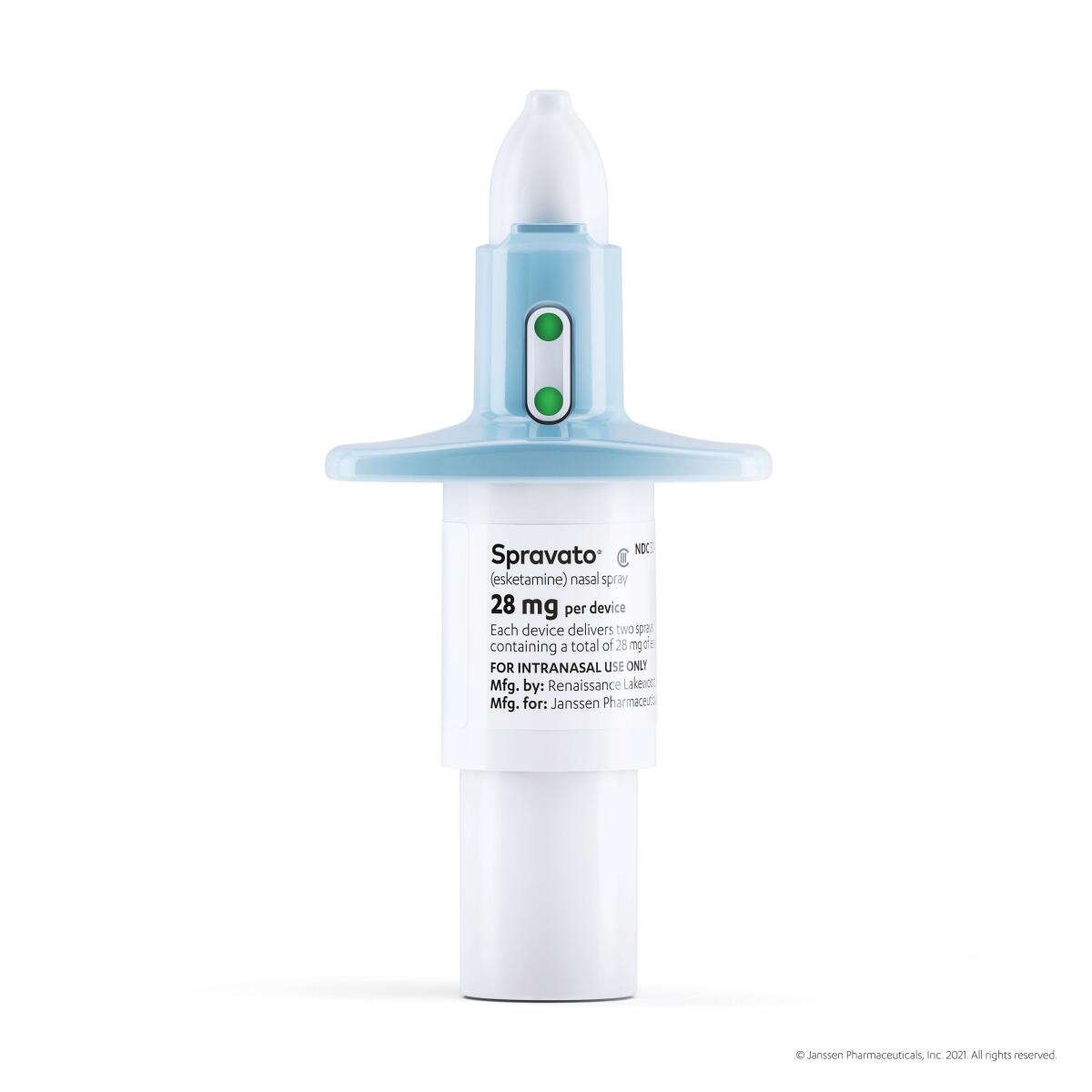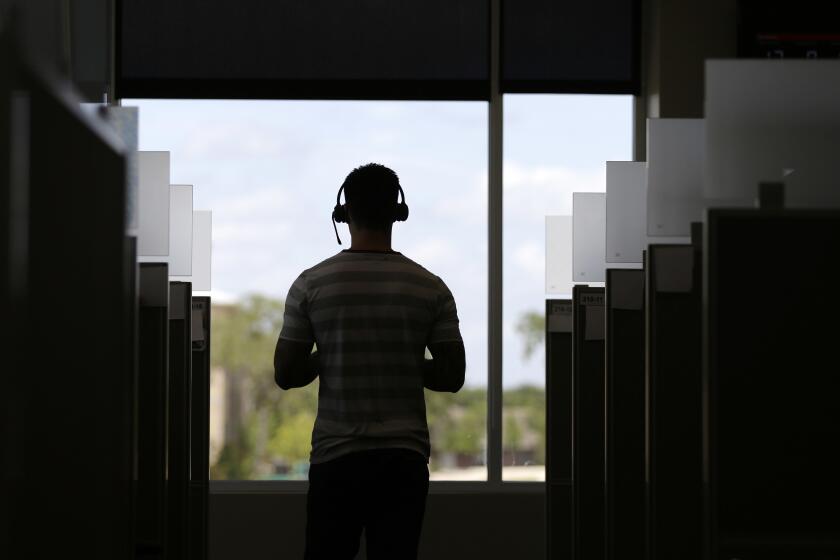Three years after clinical trial, ketamine provides hope for severely depressed

Patients arriving at Dr. Philip O’Carroll’s Newport Beach office for their first ketamine treatment are in pain and often lost. They have visited other doctors, tried other solutions and are ready for what is considered a last resort.
They are led to a private room with a reclining lounge chair. Their blood pressure is checked, and they are handed a bottle of nasal spray. One whiff into each nostril, and they feel the edges of life suddenly soften. Tranquility overcomes them.
Some listen to music. Others watch television or sit quietly, perhaps even doze, and within two hours, their discomfort and brain fog have receded. The spiral of thoughts and feelings has slowed.
Since its approval by the Food and Drug Administration in 2019, ketamine or more specifically, its cousin — fast-acting, easily administered and insurance-billable — esketamine, has started to change the landscape of depression, especially where it borders on suicide.
How To Save A Life
Pandemic stress, traumatic events and economic uncertainty have upended our world. This series aims to make the cascade of threats to your mental health a little easier to manage.
O’Carroll is not a psychiatrist, but with 40 years of experience as a neurologist in private practice in Orange County, he has come to believe that there is little separating the mind and body. When one is sick, the other follows suit, and esketamine, he says, is a bridge between them, easing the distress that can be quite profound.
“It doesn’t work for everyone,” he said, “but when it does, it is truly astonishing.”
Patients visit him complaining of headaches, fatigue and numbness, but he knows these symptoms can mask severe depression, which in the worst cases neither popular antidepressants nor psychotherapy can help.
Of the estimated 21 million Americans who have experienced a major depressive episode — for whom a wide range of effective treatments is available — close to 20% exhibit what is known as treatment-resistant depression, for which esketamine is offering hope.
“The allure of esketamine,” said O’Carroll, “is that it works quickly. Instead of four to six weeks as with other medications, it may take four to six hours, and in the case of suicidal ideation, it brings people back from the brink.”
For decades, pharmaceutical companies have tried to formulate a pill to cure depression. First there were tricyclic antidepressants, then there were SSRIs like Prozac and SNRIs like Cymbalta, drugs that target neurotransmitters such as serotonin and norepinephrine. But they take time to be effective and are often one step of many toward eventually treating this condition.
More specialized treatments — ECT, or electroconvulsive therapy, and transcranial magnetic and vagus nerve stimulation — are available but come with cumbersome mechanics, higher costs and side effects.
Ketamine, developed in 1962 and approved in 1970 by the FDA as an anesthetic, first gained notoriety as a recreational drug, but studies, conducted in 2000 and 2006, suggested its value for treating depression by targeting the neurotransmitter glutamate.
About 10 years ago, clinics popped up around the country, offering a generic, intravenous version, but without FDA authorization, insurance companies kept their distance and out-of-pocket costs could be $500 or more per treatment. Esketamine has changed that (most insured patients pay only a copay).
One man’s death may not have been preventable, but understanding what led to it offers hope for others.
Dr. Paul Nestadt, a psychiatrist with Johns Hopkins University, helped run the clinical trial that in 2019 resulted in FDA approval. He had initially been skeptical about ketamine as viable treatment for depression, but the trials, which helped determine the best application of the drug, changed his mind.
Three years later, he has seen promising results from the use of esketamine. He also studies the role of impulsivity in suicide, so he knows the stakes are high. “It is good to have a treatment that acts fast,” he said.
Although the data of the most recent trial in his clinic have not been reviewed, he reports about three-quarters of “very treatment-resistant patients” show significant improvement in depressive symptoms.
“And the vast majority have tried some of our best treatment options, like ECT, without results as strong as they are getting with esketamine,” he said, noting that patients take the medication in conjunction with other antidepressants and psychotherapy.
As effective as esketamine is, Nestadt believes more research is needed. The medication is not as effective on anxiety, he said, and some patients find symptoms returning once treatments taper down from weekly to monthly.
The new 988 number is meant as an alternative to 911. But how does it work? And is it safe to call?
A study published last month cited dizziness, nausea, sedation, vertigo and increased blood pressure after the first week of treatment, which is why O’Carroll, Nestadt and their staff monitor patients for the two-hour treatment. In addition, a few patients begin to feel an uncomfortable out-of-body sensation as the drug takes effect.
“That can be quite scary,” said O’Carroll, “so we treat it with Valium or Xanax.”
O’Carroll and Nestadt express a wariness toward the continued proliferation of unregulated spa-like clinics that prescribe a generic, non-FDA approved version of ketamine, either as an IV transfusion or a tablet, after an in-person or virtual consultation.
“They are dealing with a very vulnerable patient population who is desperate for anything new to try,” said Nestadt. “People are suffering, and we have treatments that work the majority of the time, but instead they are reeled in by some Silicon Valley-backed guru.”
O’Carroll is similarly conservative, arguing for careful oversight in the administration of ketamine and potentially other similar drugs.
One in a class of psychedelic-like medicines, ketamine joins LSD, ecstasy and psilocybin whose ability to create new connections in the brain — dendritic spines and axons — has provided researchers with a new understanding of the nature of depression and its cure.
Feeling sad or hopeless ? These 12 beautiful places in Los Angeles will lift your spirits.
More to Read
Sign up for Essential California
The most important California stories and recommendations in your inbox every morning.
You may occasionally receive promotional content from the Los Angeles Times.















